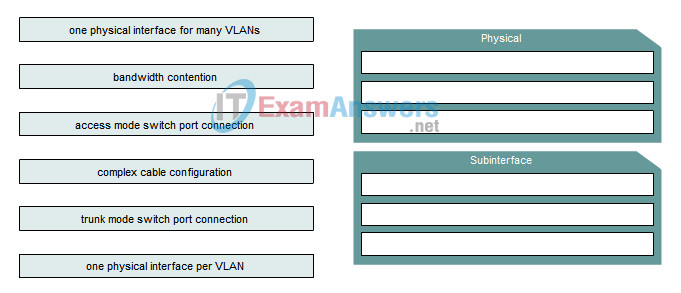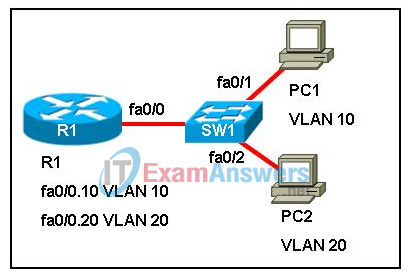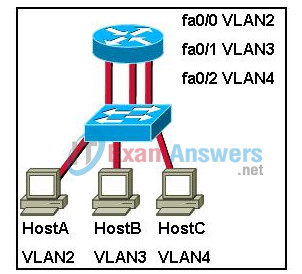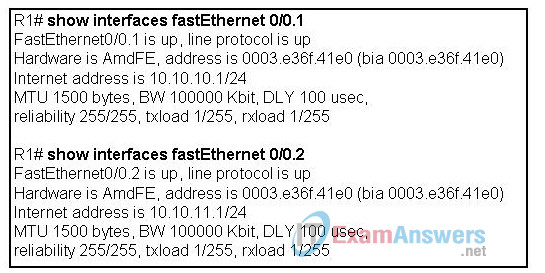1. Drag the properties associated with interfaces on the left to the appropriate interface type on the right.

Answer

2. Refer to the exhibit. PC1 wants to send data to PC2, but does not know the MAC address of PC2. When PC1 sends an ARP request, which interface returns a MAC address?

- Because PC1 and PC2 are connected to the same switch, PC2 supplies its MAC address.
- The switch provides the MAC address of the fa0/1 interface.
- Because the subinterfaces on the router have unique MAC addresses, subinterface fa0/0.10 supplies its MAC address.
- The router supplies the MAC address of physical interface f0/0.
3. Refer to the exhibit. What are three advantages of replacing the individual VLAN links between the switch and the router with a trunk line and subinterfaces? (Choose three.)

- It would free 2 switch and router ports.
- It would reduce the complexity of the cabling runs.
- It would increase the amount of bandwidth available for inter-VLAN routing.
- It would allow for less complex troubleshooting of inter-VLAN routing issues.
- It would allow adding more VLANs without requiring more cabling or switch ports.
- It would allow for less complex configuration of inter-VLAN routing.
4. What condition is required to enable Layer 3 switching?
- The Layer 3 switch must have IP routing enabled.
- All participating switches must have unique VLAN numbers.
- All routed subnets must be on the same VLAN.
- Inter-VLAN portions of Layer 3 switching must use router-on-a-stick.
5. When implementing router-on-a-stick, what is necessary for establishing communication between VLANs?
- multiple switch ports to connect to a single router interface
- native VLAN IP address that is configured on the router physical interface
- all trunk ports configured in access mode
- router subinterfaces
6. Which two methodologies could be employed to reduce the risk of a failed inter-switch link disrupting inter-VLAN routing? (Choose two.)
- configure and enable EtherChannel
- disable trunking on all switch ports
- configure and enable alternate paths between switches
- assign all switch ports to separate VLANs
- configure and enable Dynamic Tree Protocol
7. Refer to the exhibit. Which three statements are true regarding this configuration? (Choose three.)

- This configuration will not scale easily.
- This configuration will limit the number of VLANs due to limitations on the number of physical interfaces the router can support.
- The connections between the switch and router are trunk links.
- All traffic between the router and the switch must be tagged with its VLAN ID.
- This configuration is not the most cost effective.
- The switch will serve as the gateway for the hosts.
8. How does the router-on-a-stick model for inter-VLAN routing differ from traditional routing?
- The router-on-a-stick model uses multiple physical interfaces on the router, each configured with a different Layer 3 address.
- The router-on-a-stick model uses a single physical interface on the switch with only the no shutdown command issued.
- The router-on-a-stick model uses subinterfaces on the router with only the no shutdown command issued on the physical interface.
- The router-on-a-stick model uses subinterfaces on the switch with only the no shutdown command issued on the physical interface.
9. Which command does the network administrator use to determine whether inter-VLAN communication is functioning?
- show vlan
- ping
- ipconfig
- show interface
10. Refer to the exhibit. What statement is true regarding the output shown?

- Each subinterface returns a unique address in response to ARP requests.
- This inter-VLAN routing configuration is not the most cost-effective or scalable.
- The router is properly configured for router-on-a-stick inter-VLAN routing between the 10.10.10.0/24 and 10.10.11.0/24 subnetworks.
- The trunk link was dynamically negotiated.
- Layer 3 addressing is not properly configured.
11. In a router-on-a-stick configuration, which two items are required to support connectivity between the router and the switch? (Choose two.)
- all ports on the switch must be configured as access ports
- router-to-switch physical interface must be configured with an IP address
- router subinterfaces must be configured with unique addresses in different subnets
- switch port that connects to the router must be configured as a trunk
- each subinterface must be configured with the no shutdown command
12. Refer to the exhibit. Which three statements are true regarding the configuration shown in the exhibit? (Choose three.)

- The links between the router and switch are access mode links.
- Each router interface requires a unique IP address on separate subnets for each VLAN.
- Each switch interface requires a unique IP address on separate subnets for each VLAN.
- Each router interface requires a no shutdown command.
- A routing protocol must be configured on the router.
- The router will be configured with the interface fastethernet0/0.2 command.
13. Of the routing types on the left, drag only the three that are valid inter-VLAN routing types to the right.

Answer

14. A network technician is configuring a router to support inter-VLAN routing. After entering the CLI global configuration mode on R1 and selecting Fast Ethernet interface F0/0/1, the network administrator attempts to enter the command encapsulation dot1q 10. The router refuses to accept this command. What could account for this failure?
- Router port F0/0/1 is not physically connected to the switch.
- VLAN0001 has been renamed.
- R1 interface F0/0/1 was configured for subinterface operation.
- This command can only be configured on router subinterfaces.
- Interface F0/0/1 on the switch is shut down.
